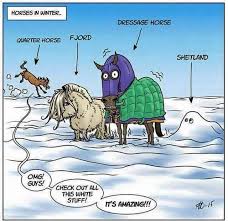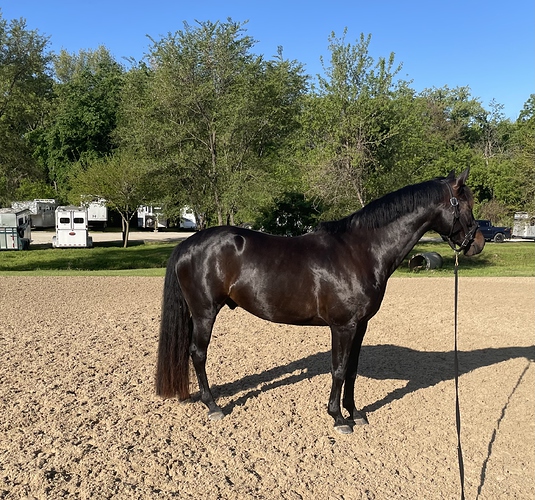Add loose salt to his daily amount of grain, vitamins. The extra salt helps in getting horses drinking more in the cold. A salt block is not enough salt, they just do not lick as much as they need. New studies are telling us we need to add loose salt daily, to keep horses where salt levels need to be. Probably for his size a couple teaspoons of salt per day is adequate. With big weather changes, drops in temps, big storm coming, you will want to double his salt quantity.
Monitor his water intake, even with a heated bucket or two. He will develop a pattern that is “normal” for him. You want to get as much water in him as possible daily, this is what prevents impaction colic.
We shorten tails in Oct, prevents hair dragging in mud, snow, to develop ice balls. You really do not want to haul a bucket of hot water out to soak off ice balls in 20F weather! If you do NOT remove iceballs, they get bigger, catch on things to pull hair out anyway. I do not put tails up, just an excuse to get snagged and pull it ALL off!! For our tall horses, this cut off is mid-cannon. On a pony, depending on your annual snowfall, shorter could be higher than that! Hair grows about an inch a month here, so the cut off length is totally grown back by March.
Get a good working snow blower. I hear 2-stage are better, more powerful than single stage models. They should be bargin priced now thru summer at garage sales, implement dealers, because it is off-season for them… Electric start saves shoulders, self-propelled with chains on wheels, are usually easier to maneuver too. Don’t get one you can’t push or turn because it is so heavy! Husband got me a big rototiller I could not even push into the garage!! I am pretty strong, can manage heavy things, but not that one!! That had to go back.
Anyway, depending on local snowfall amounts, you may need to blow off snow in the paddock, along fence lines, so pony can get around outside, see his fences. Sounds ridiculous, but totally the truth. An acquaintance had deep, heavy snow, his two Fjord mares were able to walk out over the pasture fences buried in snow!! Hunting the roving horses took some looking on cross country skis, they were miles from home, going cross-country exploring! My girlfriend says the poop just goes right thru the chute, but being frozen, just don’t aim the chute at breakable things!! Or you may have more fun getting a 4WD tractor with a bucket to move snow. Tractors can also pull out stuck cars! Ha ha





